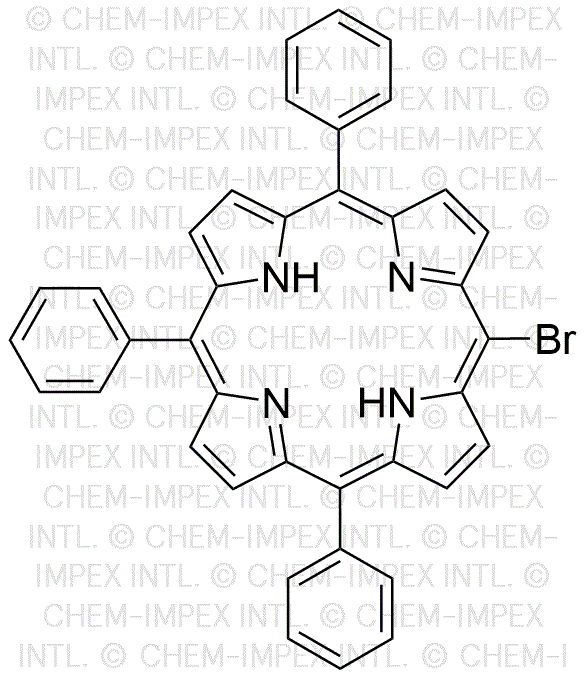5-(Bromo)-10,15,20-(triphenyl)porphyrin is widely utilized in research focused on:
- Photodynamic Therapy: This compound is used in medical applications for treating cancer. Its ability to produce reactive oxygen species upon light activation allows targeted destruction of cancer cells.
- Solar Energy Conversion: In the field of renewable energy, it serves as a photosensitizer in dye-sensitized solar cells, enhancing the efficiency of converting sunlight into electricity.
- Sensors and Biosensors: The compound's unique optical properties make it valuable in developing sensors for detecting various biological and chemical substances, providing quick and accurate results.
- Organic Electronics: It is employed in the fabrication of organic light-emitting diodes (OLEDs) and organic photovoltaic devices, contributing to advancements in flexible and efficient electronic displays.
- Catalysis: In chemical synthesis, it acts as a catalyst in various reactions, improving reaction rates and yields, which is beneficial for industrial applications and research laboratories.
General Information
Properties
Safety and Regulations
Applications
5-(Bromo)-10,15,20-(triphenyl)porphyrin is widely utilized in research focused on:
- Photodynamic Therapy: This compound is used in medical applications for treating cancer. Its ability to produce reactive oxygen species upon light activation allows targeted destruction of cancer cells.
- Solar Energy Conversion: In the field of renewable energy, it serves as a photosensitizer in dye-sensitized solar cells, enhancing the efficiency of converting sunlight into electricity.
- Sensors and Biosensors: The compound's unique optical properties make it valuable in developing sensors for detecting various biological and chemical substances, providing quick and accurate results.
- Organic Electronics: It is employed in the fabrication of organic light-emitting diodes (OLEDs) and organic photovoltaic devices, contributing to advancements in flexible and efficient electronic displays.
- Catalysis: In chemical synthesis, it acts as a catalyst in various reactions, improving reaction rates and yields, which is beneficial for industrial applications and research laboratories.
Documents
Safety Data Sheets (SDS)
The SDS provides comprehensive safety information on handling, storage, and disposal of the product.
Product Specification (PS)
The PS provides a comprehensive breakdown of the product’s properties, including chemical composition, physical state, purity, and storage requirements. It also details acceptable quality ranges and the product's intended applications.
Certificates of Analysis (COA)
Search for Certificates of Analysis (COA) by entering the products Lot Number. Lot and Batch Numbers can be found on a product’s label following the words ‘Lot’ or ‘Batch’.
Número de catálogo
Número de lote/lote
Certificates Of Origin (COO)
This COO confirms the country where the product was manufactured, and also details the materials and components used in it and whether it is derived from natural, synthetic, or other specific sources. This certificate may be required for customs, trade, and regulatory compliance.
Número de catálogo
Número de lote/lote
Safety Data Sheets (SDS)
The SDS provides comprehensive safety information on handling, storage, and disposal of the product.
DownloadProduct Specification (PS)
The PS provides a comprehensive breakdown of the product’s properties, including chemical composition, physical state, purity, and storage requirements. It also details acceptable quality ranges and the product's intended applications.
DownloadCertificates of Analysis (COA)
Search for Certificates of Analysis (COA) by entering the products Lot Number. Lot and Batch Numbers can be found on a product’s label following the words ‘Lot’ or ‘Batch’.
Número de catálogo
Número de lote/lote
Certificates Of Origin (COO)
This COO confirms the country where the product was manufactured, and also details the materials and components used in it and whether it is derived from natural, synthetic, or other specific sources. This certificate may be required for customs, trade, and regulatory compliance.


